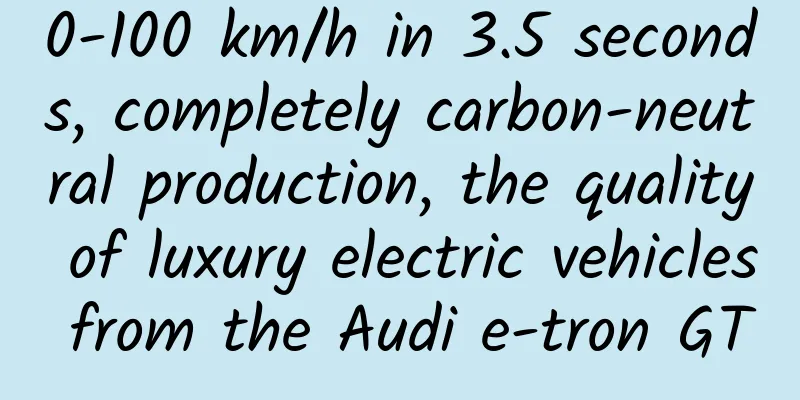0-100 km/h in 3.5 seconds, completely carbon-neutral production, the quality of luxury electric vehicles from the Audi e-tron GT

|
If 2020 was the year when new energy vehicle manufacturers came to the fore, then 2021 may be a new year in which traditional car companies fight back. It is undeniable that the rise of electric vehicles has broken the market structure that has been inherited by the automotive industry for a hundred years, and has completely ridiculed many rules of the "old era". But as traditional automakers such as Audi accelerate their electrification transformation, can Tesla and other companies really become the gravediggers of the old order like Apple phones? Everything has just begun and the future is still full of great uncertainties. As Volkswagen Group CEO Herbert Diess challenged Musk on Twitter, "Our ID.3 and e-tron have already won in the European market. We look forward to more fruitful discussions with you." In the past few years, electric vehicles have seen rapid iterations in terms of battery life and performance, as well as the creation of a luxurious exterior and interior. New forces without any baggage have been actively forging ahead, and their determination and willingness to rewrite the industry's "wealth code" are beyond words. However, at this year's CES, on the electric vehicle stage, we heard the clear whistle from traditional car companies. The traditional car companies that blew the horn of electrification chose to use product strength to illustrate a fact - even if electric motors are used to replace internal combustion engines, the century-old technology and brand accumulation of the old powerhouse will still shine. At this year's CES, Audi changed its previous large-scale concept output and chose a realistic strategy of single-point breakthrough, devoting all its space to its pure electric high-performance product that will be launched this year, Iron Man's car - the Audi e-tron GT. As the first high-performance pure electric sports car among traditional car companies, the e-tron GT condenses Audi's advanced car-making concept, with an avant-garde appearance, luxurious interior and powerful performance. It also implements Audi's "carbon neutral" production concept and uses 100% ecological electricity and renewable energy in mass production, allowing technology and environmental protection to resonate and coexist harmoniously. Both inside and outside, stunning appearance For luxury models, users expect fashion and exquisiteness. They even have reason to ask it to lead the design trend of the car's appearance. Luxury not only reflects the present, but also means that it will be unique for a long time in the future. Design is something mysterious but within reach. Last year, some new energy vehicles failed in this "feeling". Although they were promoting the slogan of "challenging luxury models", they lost at the starting line in terms of appearance. Audi, which has been a trendsetter in the industry for a century, naturally has nothing to worry about. The design of the e-tron GT was personally handled by Audi Design Director Marc Lichte. In addition to the family's traditional design language, it also retains some of the design essence of fuel vehicles. Users can tell its sports car origins just by looking at its waistline. The Audi e-tron GT has straight and powerful lines. The flat battery floor structure brings better body proportions and a lower center of gravity. The huge 22-inch wheels and low-lying shape are full of tension. The advanced battery layout allows the Audi e-tron GT's body to reach a height of 1.38 meters, like a fuel sports car. Combined with a length of 4.96 meters and a width of 1.96 meters, the slender and wide proportions form a perfect sports car form. The lower frontal cross-sectional area, numerous body aerodynamic kits, wheel arch air intakes and huge rear diffuser all emphasize the streamlined aerodynamic characteristics of the new Audi e-tron GT. Lower wind resistance also brings lower power consumption and higher speed to the Audi e-tron GT. Although it has come to a pure electric platform, the Audi e-tron GT still retains the iconic octagonal grille shape on the front, and the headlights continue to use the classic array design. The narrow and long appearance is not large in area, but the details are rich enough to catch the eye. The back inherits the through-type headlights from the e-tron, forming a separated shape at the edge, which is highly recognizable. The e-tron GT with a wheelbase of 2.9 meters offers four doors and four seats. In addition to meeting sports performance, it also takes into account the user's home needs. The sports seat design derived from racing cars can provide sufficient lateral support to passengers when cornering at high speeds, achieving a balance between performance and comfort in the riding experience. In terms of human-machine interaction, the e-tron GT inherits Audi's highly acclaimed MMI operating mode. The wraparound cockpit adopts a concise design language, with simple lines outlining a strong sense of unity, and the leather and microfiber-wrapped interior provides a low-key luxury texture. It is worth praising that the Audi e-tron GT, adhering to the concept of environmental protection, has completely abandoned animal fur products and selected sustainable materials that are environmentally friendly but more technological. The seat surface uses exquisite synthetic leather, the seat cushions, armrests, ceiling linings and window pillars use renewable microfiber materials, and even the carpet is made of recycled fibers. The design and material selection of the exterior and interior not only reflect Audi's attitude towards environmental protection, but also reflect its advanced design concept for luxury cars. Moreover, unlike the conventional sports car design that abandons the driving experience, the Audi e-tron GT fully considers the user experience while emphasizing performance. Powerful and worthy of the RS name As a milestone product of the Audi RS (Racing Sports) series, the Audi e-tron GT is naturally still built by its elite team. However, as the power system moves closer to electrification, its full-time four-wheel drive system has also been upgraded to e-quattro. The Audi e-tron GT has an astonishing power of 434 kilowatts (590 horsepower). The two permanent magnet synchronous motors at the front and rear dynamically coordinate the power distribution between the front and rear axles and between the left and right wheels under the e-quattro system to achieve the strongest driving force release under different working conditions. The battery capacity of the Audi e-tron GT reaches 90kWh. The lower battery module design successfully lowers the center of the car, providing an overall experience comparable to the Audi R8. The driver can get a more stable posture and steering support when driving at high speeds. In the era of fuel vehicles, performance is the absolute product moat of high-end brands. Now that electrification is on the rise, new car companies can also accelerate from 0 to 100 kilometers in less than 5 seconds. But just like mobile phone running scores, two mobile phones can have the same score, but the overall experience is worlds apart. Similarly, even for electric vehicles, in the face of increasingly similar zero-to-hundred performances, we need to see more powerful hardware performance tuning and superb aerodynamic design. The Audi e-tron GT accelerates from 0 to 100 km/h in just 3.5 seconds and from 0 to 200 km/h in just 12 seconds. Its top speed is set at 240 km/h in exchange for a longer driving range. Even at such a violent speed, the car's driving range can reach 400 km according to WLTP. In other words, this range is comparable to that of fuel vehicles of the same level. In fact, this is indeed the case. At the CES 2021 online press conference, Audi also invited Lucas di Grassi, a professional driver from the Formula E Championship (FE), to test drive the car on the closed airport runway in Rhode Island. Grassi was amazed after the test drive and said that the e-tron GT was "the fastest accelerating Audi car I have ever driven." Process iteration, production is completely "carbon neutral" In terms of production, the Audi e-tron GT adopts the high-performance pure electric J1 platform jointly developed with Porsche. To ensure its excellent handling and collision safety performance, the body frame uses a large amount of ultra-high-strength steel and aluminum materials. The innovative production method allows each body frame to be assembled through a circular bidirectional frame machine and passed through the welding line twice to complete the entire assembly, and ten robotic arms complete the connection between the inner and outer panels of the body side. The welding line adopts a new online measurement and detection technology to achieve higher precision measurement accuracy and can respond quickly to small deviations. The last process of the welding line is for experienced welding technicians to manually complete the welding of complex accessories that cannot be achieved by machines, and conduct a final inspection of the entire body frame, which fully reflects the essence of Audi's craftsmanship. The Audi e-tron GT and Audi R8 share the same assembly line at the Böllinger Höfe plant in Germany. This approach of integrating two technically completely different models into one production line is unique in the Volkswagen Group. Both models are moved using the same driverless transport vehicle and electric monorail system. When they arrive at a station on the assembly line, people and machines will perform high-precision collaborative assembly. Another thing that must be mentioned is Audi's unremitting pursuit of environmental protection in the production process of the e-tron GT model. It is reported that the Audi e-tron GT has achieved carbon neutral production. As of 2020, the factory is fully powered by ecological electricity. A biogas thermal power plant provides the factory with the heat needed for production. The production process avoids paper and packaging waste, adopts aluminum closed loop and polymer closed loop, and uses carbon credits from certified climate protection projects to offset currently unavoidable carbon emissions. The Audi e-tron GT is also the first Audi model that does not use any physical prototypes, but is tested through a self-developed virtual reality program. Just like the development process of modern cutting-edge weapons, there is no need for physical test explosions, and everything can be completed through supercomputer simulation, consciously and to the highest extent possible, implementing the concept of environmental protection. In fact, whether it is the meticulous control of details in the production process or the adequate measures for environmental protection, it all reflects Audi's high sense of responsibility as a car company for the current society and the sustainable development of mankind in the future. Don’t think that “sense of responsibility” is a bluff. Among all high-end brands, just like the declaration that luxury goods will no longer use animal fur, “sense of responsibility” is the most important commitment of the brand to users, and it is also the only manifestation of the mutual trust between products and users in spiritual level. What exactly are users who choose luxury cars buying? So, for a top luxury car, what qualities should it have in order to resonate with users' values? In the past, the market generally believed that performance, quality materials, craftsmanship and branding dominated the user's overall decision-making. Today, this standard is still as new as ever. When users pay a high cost for luxury cars, they naturally realize that the price includes a premium. For this reason, luxury cars are by no means simply a means of transportation. They have reason to demand driving quality, powerful performance, more high-end materials, more refined craftsmanship and more profound brand connotations. In the era of fuel vehicles, the concept of luxury cars by European and American manufacturers is mainly anchored in brand temperament and strong performance. For example, Audi used to sweep various competitions with quattro, and was eventually required by many competition organizers to compete with weight, and was eventually banned by the International Automobile Federation (IFA) to ensure the viewing and diversity of the competition. There is no doubt that the outstanding results in the competition are an endorsement of the performance of Audi cars. At a time when electric motors are gradually replacing internal combustion engines, new energy vehicles have greatly narrowed the performance gap between different automakers, and the performance gap between luxury models has been almost crossed in one step. However, even so, we still cannot ignore the fact that luxury car users who are fanatical about performance will inevitably have almost "irrational" and strict requirements for driving quality, craftsmanship and materials, and brand image, which cannot be achieved overnight because it requires sufficient time for precipitation and accumulation. Putting aside the pure products, it is still a bit difficult for new energy car manufacturers to maintain their luxury car positioning for a long time in terms of brand power and product power. Compared with traditional car companies, they still have a long way to go and many "pitfalls" to step on. In fact, just as the novelty wears off, when traditional car companies are fully prepared to officially switch to electric platforms, more consumers will still return to strong traditional brands, because this means a century of trust. Take Audi's upcoming e-tron GT as an example. In addition to squeezing out the performance of two permanent magnet synchronous motors, it inherits the exterior design language of the Audi family, a new iteration of quattro technology after 30 years of technological accumulation, aerodynamic design evolved over many years on the track, a manufacturing process that requires manual polishing of subtle details, and future-oriented full-process carbon neutrality, all of which demonstrate the technical embodiment and market accumulation of the Audi brand in the field of luxury models. It can be said that Audi has redefined what a luxury electric sports car is with this car, and it is really not just as simple as a single 0-100 acceleration. What are the users who choose luxury electric cars buying? Faced with this question, Audi, which pioneered the e-tron GT, gave a 99-point answer. As a winner of Toutiao's Qingyun Plan and Baijiahao's Bai+ Plan, the 2019 Baidu Digital Author of the Year, the Baijiahao's Most Popular Author in the Technology Field, the 2019 Sogou Technology and Culture Author, and the 2021 Baijiahao Quarterly Influential Creator, he has won many awards, including the 2013 Sohu Best Industry Media Person, the 2015 China New Media Entrepreneurship Competition Beijing Third Place, the 2015 Guangmang Experience Award, the 2015 China New Media Entrepreneurship Competition Finals Third Place, and the 2018 Baidu Dynamic Annual Powerful Celebrity. |
<<: Tesla's old Model 3 price cut by RMB 10,000 to clear inventory, netizens: Don't be fooled
>>: Xinfei Electric is lost and its brand is gradually losing its commercial value
Recommend
Operations: Where is the entry point to find accurate users? ?
one. Definition and classification of users 1. De...
SpaceX monopolizes the moon landing contract, Blue Origin sues NASA, will the plan to return to the moon fail?
NASA (National Aeronautics and Space Administrati...
Cryo-EM sees real atoms! Does it look like what science predicts?
All matter on Earth is made up of atoms, which ar...
Masayoshi Son predicts that human driving will be replaced by autonomous driving within 50 years, and SoftBank is making all-round arrangements for autonomous driving
On the 19th of last month, Son Masayoshi predicte...
How much does it cost to customize the Chengde housekeeping mini program?
There is no fixed price for the customization of ...
Faraday Future is sued by Fuzhuo for $10 million in overdue payments
Recently, it was reported that Faraday Future, wh...
Search Ads Keyword Optimization Guide
New feature of Baidu Marketing Optimization Cente...
On my journey after quitting my job: I wrote an app and started a company
[[127859]] A year ago, I left San Francisco, sold...
WeChat Moments advertising marriage industry case sharing: Panzi Nvrenfang
Plate Woman's Square The “breathing” ad space...
Why do fish have to have spines? Will the fish be pricked by the spines?
Fish is a common dish on the Chinese New Year tab...
Three Mentality of Chinese People When Buying Mobile Phones
Buying a mobile phone is a complicated process. T...
I thought it was a stomach problem, but it turned out to be a myocardial infarction! During the rainy season, be alert to this symptom!
In recent days, at Zhejiang Provincial People'...
Corolla's monthly sales of 2,268 units lead Taiwan Province. If mainland cars enter Taiwan, how will the market change?
In recent days, Taiwan has been a very hot word, ...
Analysis of AARRR models of Starbucks, luckin coffee, Pinduoduo, etc.!
In the user operation system, there is a classic ...
Xpeng and NIO are entering the lower-tier markets with their products priced below 200,000 yuan. Are they the new rivals of Xiaomi SU7?
Recently, there have been reports that NIO plans ...









